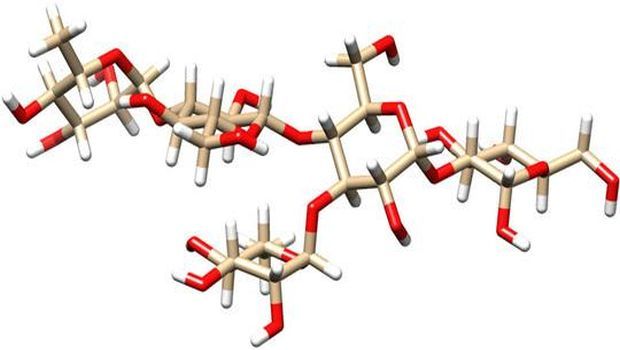Fighting Hospital Pathogens With Sugar
A vaccine against one of the most dangerous hospital germs may soon be available. Scientists from the Max Planck Institute of Colloids and Interfaces in Potsdam and the Freie Universität Berlin have developed a substance that elicits an immune response against the gut bacterium Clostridium difficile. The potential vaccine resembles the sugar structures presented on the surface of the bacterium and therefore primes the immune system to recognize the pathogen itself. C. difficile infects a large proportion of patients in hospitals and kills around 15,000 people a year in the U.S. alone. Doctors could treat the infection with antibiotics, but the bacterium mutates constantly, allowing it to escape the effects of the drugs. The discovery by the Max Planck researchers may pave the way for developing inexpensive and effective vaccines and drugs against C. difficile.


A sweet spot for therapeutic antibodies: This illustration shows the three-dimensional structure of the sugar molecule PS-I of C. difficile (orange: carbon; red: oxygen; white: hydrogen). Courtesy of MPI of Colloids and Interfaces
A vaccine against one of the most dangerous hospital germs may soon be available. Scientists from the Max Planck Institute of Colloids and Interfaces in Potsdam and the Freie Universität Berlin have developed a substance that elicits an immune response against the gut bacterium Clostridium difficile. The potential vaccine resembles the sugar structures presented on the surface of the bacterium and therefore primes the immune system to recognize the pathogen itself. C. difficile infects a large proportion of patients in hospitals and kills around 15,000 people a year in the U.S. alone. Doctors could treat the infection with antibiotics, but the bacterium mutates constantly, allowing it to escape the effects of the drugs. The discovery by the Max Planck researchers may pave the way for developing inexpensive and effective vaccines and drugs against C. difficile.
Around 40 percent of patients in hospitals and nursing homes carry the gut bacterium C. difficile. Such patients are easy prey for the pathogen. Because the patients' intestinal flora is often damaged by antibiotic treatments, the bacteria are able to spread unhindered. Moreover, treatment of the infection becomes increasingly difficult, as the bacteria tend to develop resistance to antibiotics.
Researchers at the Max Planck Institute of Colloids and Interfaces have now constructed a molecule that could protect patients against C. difficile. It resembles the characteristic sugar coating on the surface of bacteria and, as such, is able to elicit a similar immune response as the bacterium itself. The molecule could thus be used as a vaccine, because once the immune system has produced antibodies against a pathogen, it is prepared to fend off the invaders in the event of a later infection.
The researchers first investigated which parts of the sugar coating are actually necessary to trigger an immune response. They then constructed an artificial molecule with those properties by attaching the essential sugar structures to an amino acid backbone. Coupled with an immunostimulating peptide, the molecule stimulated the immune system in mice to produce antibodies that were effective against the similarly constructed surface sugars of C. difficile. The mice are therefore protected against a subsequent infection with the bacterium. Moreover, it may be possible to use the molecule to produce therapeutic antibodies that can be administered to sick patients to boost their immune system and combat infections.
Many bacteria bear characteristic carbohydrates on their surface, and it is known that these surface sugars are suitable for immunization purposes. However, the surface sugars usually have to be detached from specially bred microbes - an expensive and complicated process. By synthesizing artificial molecules for immunization, the researchers have now come up with a cost-effective alternative. "Our findings are a very good example of how basic research into the human immune response to sugars can lead to new candidates in the fight against dangerous hospital germs," says Peter H. Seeberger, director at the Max Planck Institute of Colloids and Interfaces and professor at Freie Universität Berlin. As early as 2011, he and his team synthesized a molecule for immunizing against C. difficile; at the time, however, they used a different surface sugar molecule as a template.
In order to progress from research results to actual use in patients, the scientists at the Max Planck Institute of Colloids and Interfaces in Potsdam are working with Vaxxilon AG (Reinach, Switzerland) to develop novel carbohydrate-based vaccines. Vaxxilon has licensed a portfolio of vaccine candidates against a number of pathogens, including C. difficile.
Reference: Broecker F, et al. Multivalent display of minimal Clostridium difficile glycan epitopes mimics antigenic properties of larger glycans. Nature Communications 7:11224 (April 2016)
Source: Max-Planck-Gesellschaft
Understanding the True Threat: Richard Webby, PhD, on H5N1 Avian Flu and Its Human Impact
January 3rd 2025Richard Webby, PhD, the director of the World Health Organization (WHO) Collaborating Centre or Studies on the Ecology of Influenza in Animals and Birds, discusses the evolving dynamics of H5N1 avian flu, its variants, and the low risk to humans while emphasizing vigilance among health care professionals.
Top 7 Infection Control Today Articles of 2024: Insights and Innovations
December 30th 2024From advanced sterilization methods to combating antimicrobial resistance, Infection Control Today’s top articles of 2024 delivered actionable strategies for safer healthcare environments and improved patient outcomes.
Revolutionizing Infection Prevention: How Fewer Hand Hygiene Observations Can Boost Patient Safety
December 23rd 2024Discover how reducing hand hygiene observations from 200 to 50 per unit monthly can optimize infection preventionists' time, enhance safety culture, and improve patient outcomes.
Redefining Competency: A Comprehensive Framework for Infection Preventionists
December 19th 2024Explore APIC’s groundbreaking framework for defining and documenting infection preventionist competency. Christine Zirges, DNP, ACNS-BC, CIC, FAPIC, shares insights on advancing professional growth, improving patient safety, and navigating regulatory challenges.
Addressing Post-COVID Challenges: The Urgent Need for Enhanced Hospital Reporting Metrics
December 18th 2024Explore why CMS must expand COVID-19, influenza, and RSV reporting to include hospital-onset infections, health care worker cases, and ER trends, driving proactive prevention and patient safety.